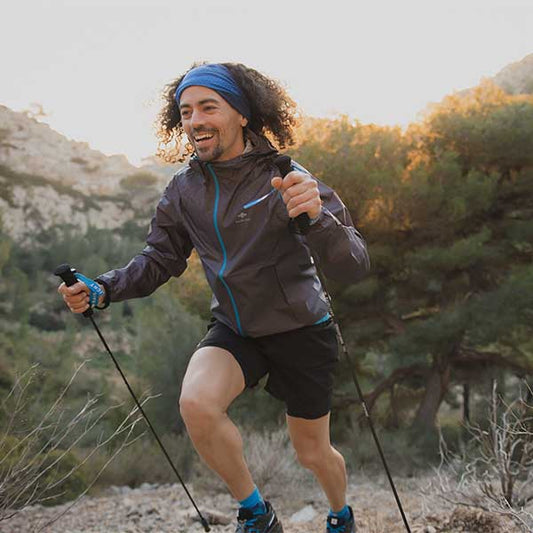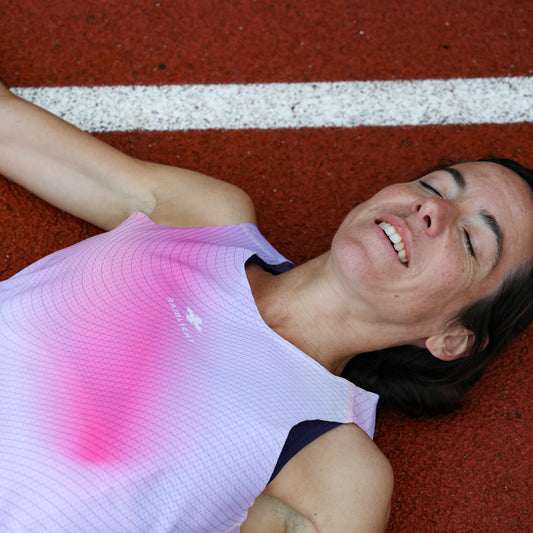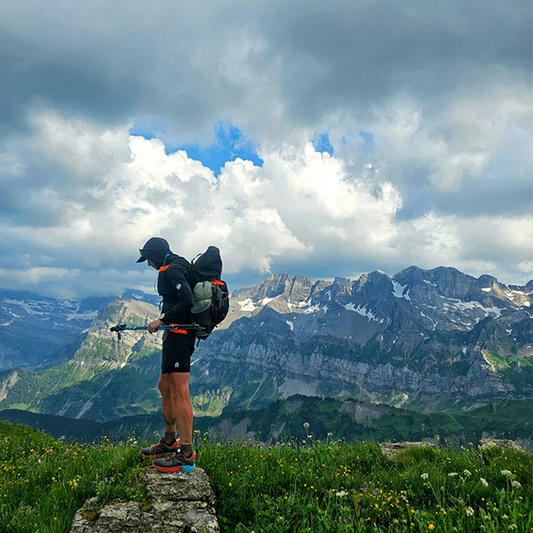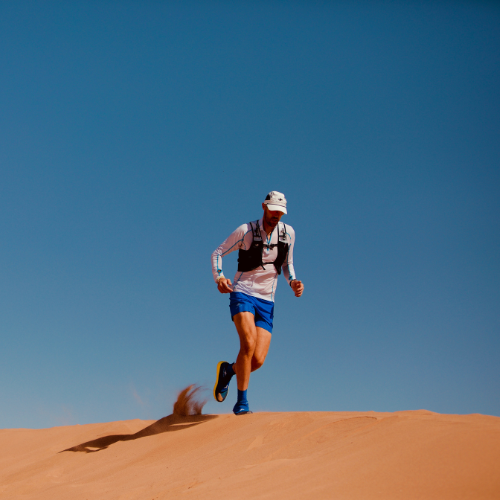The Marathon des Sables® is a mythical event, an extreme challenge in which the management of effort, equipment and mental strength are of paramount importance, as you have to run self-sufficiently in temperatures that can exceed 50°C.
We're lucky enough to share with you the advice of Mérile ROBERT, a Marathon des Sables® regular with seven participations, including two podium finishes in 2018 and 2021. Thanks to his experience on prestigious Ultra Trails, such as the UTMB®, he also won the Grand to Grand Ultra in the USA in 2022. For the MDS®, he has fine-tuned his equipment and preparation to compete with the Moroccan elite.
If you're taking part in the 2025 edition, you might just come across him, this time alongside a joëlette team. Don't hesitate to go and meet him!

Mérile, what are your training secrets for the Marathon des Sables®?
“Preparation for the Marathon des Sables® is mainly based on a gradual increase in training distances, with the emphasis on flat terrain. The main objective is to optimize your running economy to reduce the effort required for each step. This ability is perfected by exposing yourself directly to the demands of the event.”
“The 2 key points of training :
1. Build stamina and endurance
Endurance is essential in preparation. Gradually increase the training load by adding long outings with a 6 to 8 kg bag. The aim is to get the body used to working under load.
Preparation must also reflect the specific features of the test:
- Long efforts repeated over several days.
- A hot, monotonous course. You have to get used to moving along long straight lines, like those of a canal, to prepare yourself mentally..
2. A gradual build-up
A preparation cycle of 7 to 8 months is necessary, with a gradual build-up. By December, you should be able to run 50 to 60 km a week.
Twice-daily training is a good strategy for increasing volume and improving recovery. In this way, the body adapts to keep up with the distance. At Marathon des Sables®, recovery is just as crucial as progress.
“Recovery starts as soon as you cross the finish line and plays a key role in being able to set off again each day in the best possible condition.”

What about the sand? How do you deal with the terrible dune crossings?
“Contrary to what you might think, only 20-30% of the course is sand. The rest is hard tracks, stony paths and uneven ground. So it's essential to vary your training terrain to get used to less regular footing and develop a good feel for the ground. Avoid running only on asphalt or overgroomed trails.
In your opinion, what are the 3 key points of race management?
“Beyond the volume of training, it is essential to acquire specific skills:
- Learn to manage effort and run/walk at average running speeds.
- Adopt a spirit of conservation, sparing your resources.
- Get used to effectively alternating running and walking, especially during long hike-run outings.
Managing boredom and staying focused
The Marathon des Sables® will put your mind to the test: endless straights, blazing sun, endless landscapes. At times like these, boredom can quickly set in and dampen your motivation.
To counteract it, focus on simple but effective actions. Use your food protocol as a guide: hydrate and eat regularly. Set reminders on your watch so you don't have to think about it. Every sip of water, every bite of food becomes a mini-goal to pace your run and keep your mind occupied.
By breaking up these long stretches into smaller stages, you can stay on course without becoming overwhelmed by monotony.
What do you do to optimize recovery between each stage?
“Recovery starts as soon as you cross the finish line and plays a key role in being able to set off again each day in the best possible condition.”
Post-exercise hydration and nutrition
The water provided at the camp is generally enough to rehydrate you after the effort. But to combine recovery with pleasure, remember to take along some tea bags or dehydrated soup. Lightweight and practical, they are a real comfort in everyday life.
Another must: the recovery drink. Rich in carbohydrates, proteins, sodium, minerals and vitamins, it helps you recharge your energy and muscle reserves after hours of exertion in sweltering heat.
Rest and active recovery
Rest, yes, but without neglecting active recovery. Walk for a few minutes after the finish line to stimulate blood circulation and facilitate recovery. And don't forget compression socks to reduce muscle fatigue and help you get back on track the next day.

The MDS® is an autonomous race. How do you advise managing food and nutrition?
“One of the most common mistakes is to leave with too much food for fear of running out.”
Prevent dehydration to face the desert better
In the extreme conditions of the Marathon des Sables, hydration is a necessity. Waiting until you're thirsty? A costly mistake. Dehydration limits performance and often strikes too late. To avoid it, drink regularly, even in small sips. A good fluid balance will help you go the distance and cope better with the scorching desert heat.
“During the race, I take neutral-tasting effort drinks, which I dilute a lot and alternate with clear water. On the bivouac, I also have a recovery drink. This is essential for replenishing levels after several hours of effort in a hot, dry environment.”
Optimum freeze-dried nutrition
“Freeze-dried dishes offer an optimal weight/calorie ratio and are easy to prepare on the bivouac. To avoid digestive problems, it's best to avoid spicy dishes. One of the most common mistakes is to leave with too much food for fear of running out. In reality, the sensation of hunger is normal, but temporary. The most important thing is to ensure that your overall energy intake is sufficient for the entire event.
The Marathon des Sables® organization has recently updated the list of compulsory equipment, adding 14 stock cubes. This new measure is designed to guarantee a supply of mineral salts and facilitate recovery, particularly in a hot and demanding environment. These cubes will be a key element in maintaining hydration and electrolyte balance throughout the event. So be sure to include this new requirement in your equipment to be perfectly prepared.
Supplement your intake with energy snacks
As a complement to main courses, certain foods can improve comfort and provide essential nutrients:
- Dried meat: rich in protein, it helps recovery and adds flavour.
- Salted oilseeds (almonds, cashews...): a source of energy, good lipids and salt, essential to compensate for losses due to perspiration.
- Freeze-dried soups: comforting and hydrating after exercise.
-
Mérile sometimes supplements his meals with vermicelli pasta, a simple solution for adjusting portions according to her energy needs.
Raidlight has teamed up with MX3-Nutrition to design freeze-dried nutrition packs. The 7-day desert pack will provide you with all the rations you need to last the duration of your race.
Discover our diet plan designed specifically for a 7-day desert race clicking this link
Do you think trail poles are useful for the MDS®?
“During the Marathon des Sables®, 60% of finishers progress at a speed of between 7 km/h and 4.5 km/h, while 26% progress at less than 4.5 km/h. These speeds clearly show the importance of walking in this event, just as much as running. That's why it's essential to work on your Nordic walking technique. This method not only helps to manage effort on difficult terrain, but also reduces fatigue by optimizing the use of the upper body and poles to maintain good speed throughout the event.”
The Raidlight desert guide: the bible for desert racing.
As a future participant, Raidlight has put together a complete guide to desert racing to help you prepare for such demanding races as the Marathon des Sables®.
As desert specialists for 25 years, we've designed this guide to accompany you and share our practical advice: preparing and organizing your trail bag, food, equipment, training, life on the bivouac... This guide is designed to meet the specific needs of trail runners, whether you're a beginner or an experienced trail runner.
Mérile also shares other practical tips, particularly on equipment.
Also discover a series of articles on our blog: training plan, tips for choosing your trail shoes, advice for preparing and organizing your trail bag...
How to prepare and organize your bag for the Marathon des Sables® or the Raidlight Desert Trophy?
By applying these tips, you'll be ready to tackle the Marathon des Sables® in the best possible conditions. Rigorous preparation, the right equipment and a well-thought-out strategy will make all the difference on the field. Stay focused, manage your effort and every detail of your preparation with care. Have a good race, and may this adventure be an unforgettable experience that will leave a lasting impression on you!











1 comment
Great article!!!!